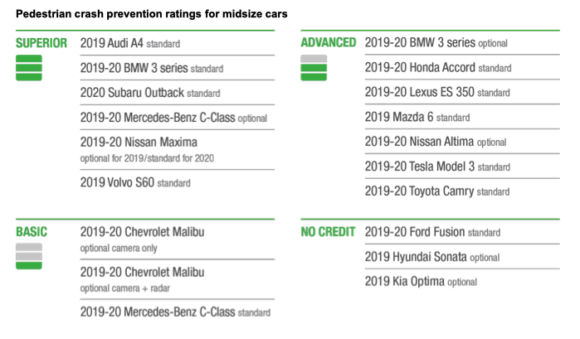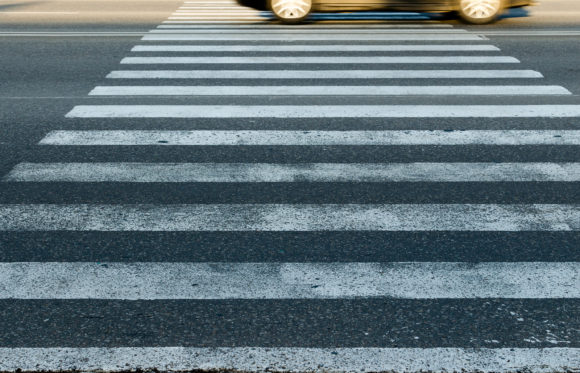Consumers don’t always have to pay extra to acquire a good pedestrian crash-avoidance system: Some of the best systems come as standard equipment, according to the Insurance Institute for Highway Safety.
The institute rated pedestrian crash prevention systems in 16 midsized cars and released the results on Monday in the lead-up to Halloween, which consistently ranks among the deadliest days for pedestrians in the United States.
The institute said four luxury and two non-luxury cars earned superior ratings, the highest possible. Six cars earned an advanced rating and four non-luxury cars received a basic rating or no credit at all, the worst possible ranking.
The Audi A4, BMW 3 series, Mercedes-Benz C-Class, Nissan Maxima, Subaru Outback and Volvo S60 rated superior because they avoided collisions or slowed substantially in track tests.
“Car makers often roll out these kinds of advanced systems in more expensive luxury lines or as expensive options, so the superior performance of the standard systems on the more mainstream Maxima and Outback is noteworthy,” said IIHS President David Harkey in a prepared statement.
Other systems proved ineffective. IIHS said the Ford Fusion, Hyundai Sonata and Kia Optima earn no credit because they failed to slow significantly in multiple scenarios.
The Mercedes C-Class, BMW 3 series and Chevrolet Malibu each offer two different pedestrian crash prevention systems. On the Mercedes, the optional system earned a superior rating, while the standard one earned a basic rating. On the BMW, the standard system surprisingly earned a higher rating of superior, while the more costly optional system ranked only as advanced. Both of the Malibu’s optional systems — a camera only and a camera plus radar — earned basic ratings.
The safety institute said a pedestrian crash avoidance system was standard equipment in all six luxury cars it tested and was standard in six of the 10 non-luxury cars.
The IIHS tested performance in three scenarios: an adult pedestrian stepping into the street in the path of the oncoming vehicle with an unobstructed view, a child darting into the street from behind two parked cars, and an adult pedestrian near the side of the road in the travel lane, facing away from traffic.
The crash-avoidance system had one or two seconds to stop the car to avoid hitting the pedestrian dummy in each testing scenario. Speeds ranged from 12 mph to 37 mph.
The institute said annual pedestrian fatalities have increased 53 percent since reaching a low point in 2009. More than 6,000 pedestrians were killed in 2018. From 2013 to 2017, the two deadliest days of the year for pedestrians on average were Oct. 31 and Nov. 1 (or after midnight on Halloween).
“Pedestrians are the most vulnerable road users, so it’s encouraging that pedestrian crash prevention systems are standard equipment in 12 out of the 16 midsize cars we tested, including five out of six superior-rated systems,” Harkey said.

Was this article valuable?
Here are more articles you may enjoy.


 Travelers Survey: Distracted Drivers Making US Roads More Dangerous
Travelers Survey: Distracted Drivers Making US Roads More Dangerous  Harvard Study Again Stirs the Pot on Demotech Ratings of Florida Carriers
Harvard Study Again Stirs the Pot on Demotech Ratings of Florida Carriers  California Chiropractor Sentenced to 54 Years for $150M Workers’ Comp Scheme
California Chiropractor Sentenced to 54 Years for $150M Workers’ Comp Scheme  Poll: Consumers OK with AI in P/C Insurance, but Not So Much for Claims and Underwriting
Poll: Consumers OK with AI in P/C Insurance, but Not So Much for Claims and Underwriting 